
You've probably heard or read about ChatGPT.
And I'm guessing you know it has something to do with AI (artificial intelligence).
But what exactly is ChatGPT and what does it do?
Below is a simple, non-technical explanation of ChatGPT to help you decide if ChatGPT is just another passing fad or something you should pay attention to and add to your digital toolbox.
ChatGPT: What is it?
ChatGPT is an online supercomputer that responds to your questions and statements in a conversational, human-like manner. It was released in November 2022.
ChatGPT can assist you with a range of tasks from writing computer code to writing essays.
The "GPT" in ChatGPT stands for "Generative Pre-trained Transformer", which is its secret sauce for recognizing the nuances of human language so it can provide you with meaningful results instead of out-of-context computer gibberish.
Think of ChatGPT like Siri or Alexa, except that ChatGPT is a text-based assistant rather than a voice-based assistant.
Who created ChatGPT?
ChatGPT was created by OpenAI, an artificial intelligence research laboratory founded in 2015 by a group of entrepreneurs and AI experts including Elon Musk, Sam Altman, Greg Brockman, Ilya Sutskever, John Schulman, and Wojciech Zaremba.
Microsoft invested $1 billion in OpenAI in 2019. As part of their partnership with OpenAI, Microsoft agreed to become OpenAI's exclusive cloud provider.
In January 2023, Microsoft announced it’s extending its long-term partnership with OpenAI through a new multiyear, multibillion dollar investment.
Rumors are that Microsoft plans to integrate ChatGPT into Bing search results and incorporate some language AI into Word, PowerPoint, and Outlook.
How ChatGPT works
ChatGPT is like a robot that understands what you say and responds back to you in a way that sounds like a real person.
It gets its information from a large dataset of text from the internet, books, articles, and websites, allowing it to generate coherent and contextually relevant responses.
Sometimes ChatGPT might not understand exactly what you're asking or it produces a response that doesn't make sense. However, the more people use it and the more it learns, the more accurate ChatGPT becomes.
Is ChatGPT free?
Yes, the basic version of ChatGPT is free to use. To sign up for a free account, visit chat.openai.com.
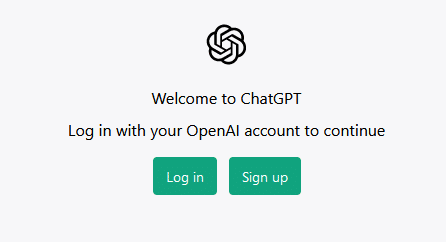
OpenAI also offers a paid version called ChatGPT Plus for $20/month.
The main differences between the free and paid plans are:
You might be wondering, "Why does OpenAI offer a fully-functional, free version of ChatGPT?"
Perhaps partly to fulfill their corporate mission statement to "ensure that artificial general intelligence benefits all of humanity".
But most likely to gain marketshare and first-mover advantage in the AI niche as quickly as possible with a "try before you buy" option.
It's unclear how long OpenAI will offer a free version of ChatGPT. Maybe forever. Who knows?
How to use ChatGPT
Using ChatGPT is easy:
1. Sign up for a free account at chat.openai.com.
2. Assuming their system isn't at capacity, you can start using ChatGPT right away. There's nothing to download. It's all online and the UI (user interface) looks and feels just like standard online chat.
3. The best way to get comfortable with ChatGPT is just start using it. Type in some questions or commands, then watch how it responds.
Note: At the time of this writing, there is no dedicated iOS or Android app for ChatGPT. However, you can use ChatGPT on your phone simply by logging in to your account at chat.openai.com from any mobile web browser.
ChatGPT examples
After reading a gazillion articles on "ChatGPT best examples" (as well as lots of playing around with ChatGPT Plus), here's what I believe are the 4 best business uses as well as my 3 favorite personal uses for ChatGPT:
4 best business uses for ChatGPT
1. ChatGPT eliminates writer's block.
Nothing kills or delays more projects than writer's block.
But ChatGPT solves mental logjams by brainstorming ideas to get your creative juices flowing.
Let's say you're a dentist wanting to make a YouTube video answering common questions about dental implants, but you're racking your brain trying to come up with a title for your video. Your ChatGPT prompt could be:
I want you to act as a dentist. Please suggest 10 compelling titles for a YouTube video that answers common questions patients have about dental implants.
In less than 30 seconds, ChatGPT produces the following:
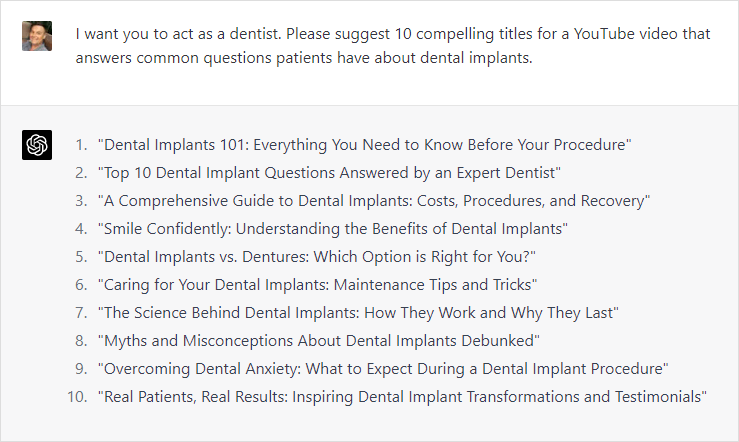
If you didn't like any of these titles, just ask ChatGPT to give you 10 more. Rinse and repeat until you find a title you like.
The possibilities for generating ideas are endless.
2. ChatGPT becomes your writing assistant.
Once you decide on a topic for your content (article, book, video, website, etc), you then have to create that content.
But anyone that's ever created content knows that just getting started can feel like rolling a boulder uphill.
Here are some ChatGPT prompts than can help you break through the inertia:
Sure, you're going to have to edit the content you receive from ChatGPT.
But it's a thousand times easier editing an existing piece of content than creating the initial draft out of thin air.
3. ChatGPT summarizes complicated or voluminous material (i.e. do time-consuming research).
No time to read a book or learn about an important topic? Ask ChatGPT to do it for you and give you an executive summary.
Here are some possible ChatGPT prompts:
Here's a screenshot of an actual ChatGPT executive summary:
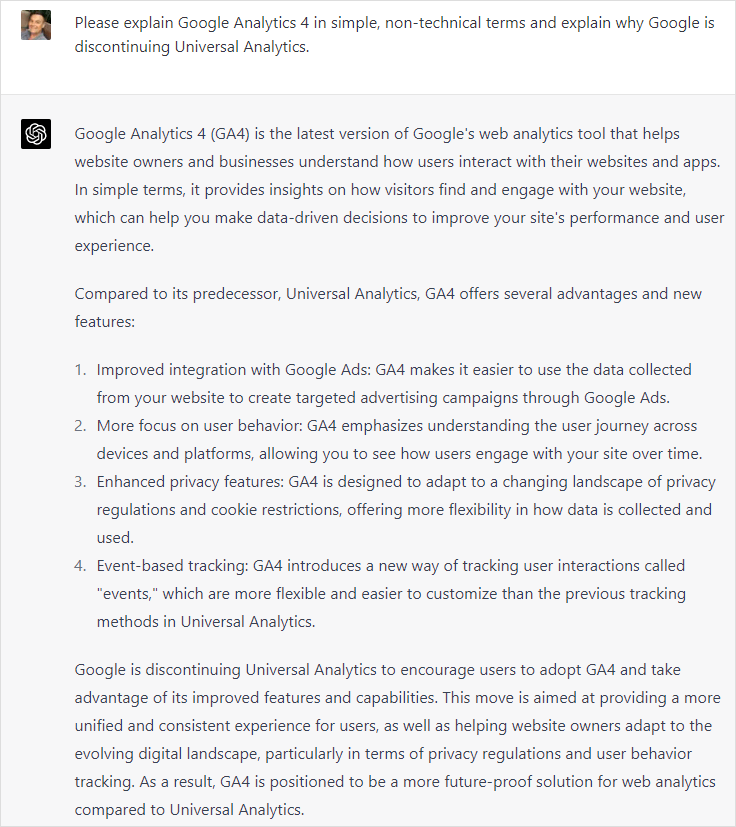
4. ChatGPT generates social media posts and ads.
Social media is an essential part of most businesses' overall marketing strategy.
The problem is that consistently publishing engaging social media posts and ads can be tedious work.
Here are some ways ChatGPT can make this easier:
Here's an example of ChatGPT creating a Facebook post for a lawn care company:
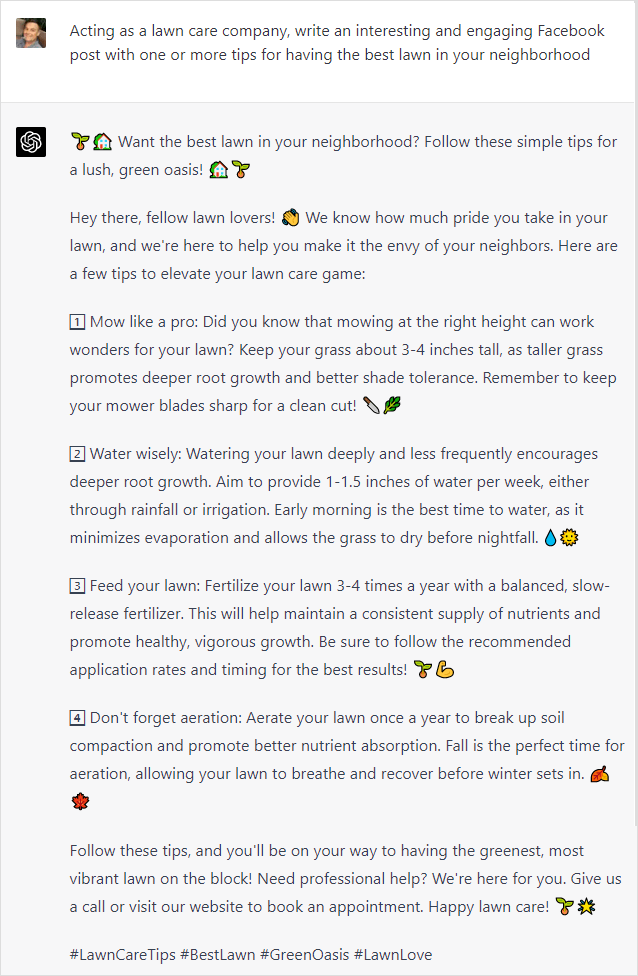
All you have to do is copy & paste this to your Facebook page and you're done.
Even if you have to do minor edits, it's still a thousand times easier editing something than creating it out of thin air.
My 3 favorite personal uses for ChatGPT
1. ChatGPT gives recommendations.
Looking for something new or different, but don't have the time for endless searching?
Ask ChatGPT to help.
Here's an example where I asked ChatGPT to give me some recommendations for stand-up comedians I might like:
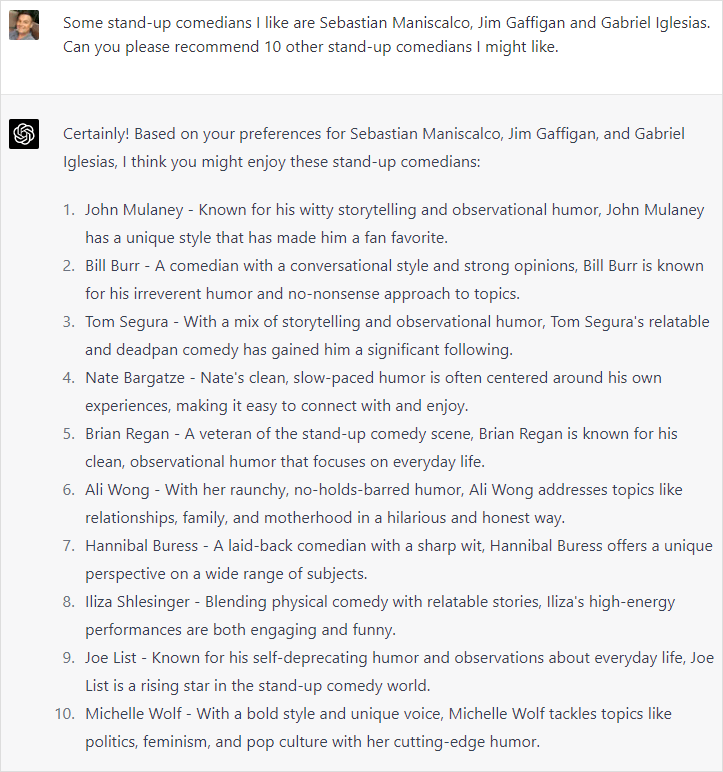
You could ask ChatGPT for recommendations on books, recipes, clothing styles, places to visit ... whatever you want.
2. ChatGPT assists with coding.
ChatGPT can quickly generate code snippets in a variety of programming languages including Python, Javascript, SQL, PHP and more.
As someone whose designed and developed business websites for 20 years, I'm fluent in HTML and CSS. So I decided to put ChatGPT to the test with the following prompt:
Please give me HTML code to create 3 red squares positioned horizontally and evenly across a page. The space between each square is 1/2 inch. The side of each square is 2 inches in length and the border is 3 pixels in width and black.
I copied the code it spit out and pasted it on a test page on my site. Here's a screenshot of the result:

Yes, this is a simple example. And yes, most websites these days are built with complex page builders like Thrive Architect.
But even if you have no interest in coding, you've got to admit it's pretty impressive that a machine can generate raw, accurate computer code in less than a minute.
3. ChatGPT provides a fun, intellectual escape.
When you've been at your desk for hours and you need a mental palate cleanse, ChatGPT can be a great alternative to social media or reading the news.
Here are some ChatGPT prompts you can use to amuse yourself:

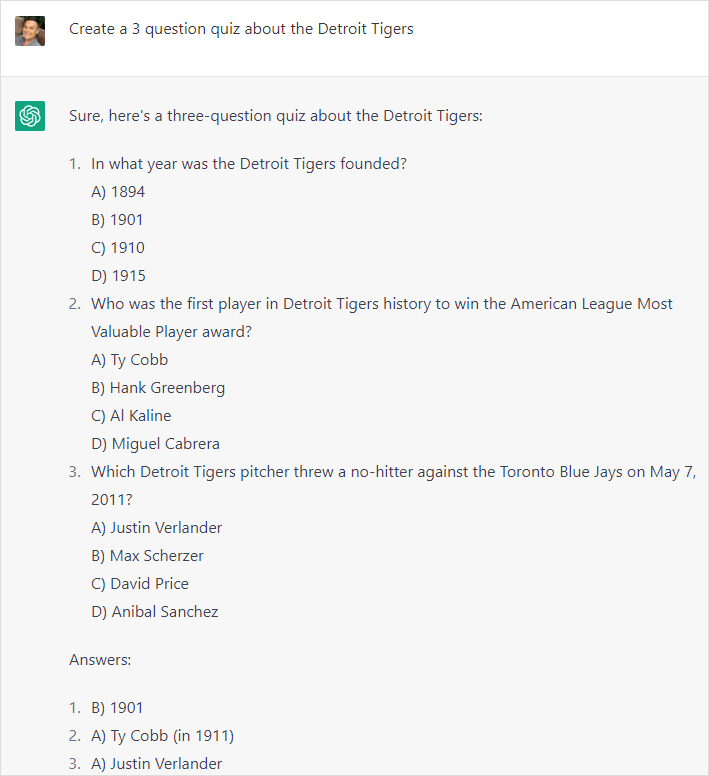
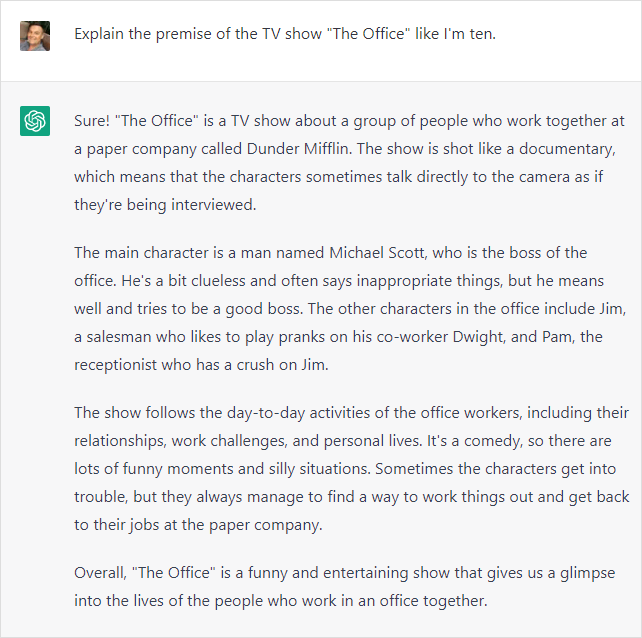
Warning: These off-the-wall ChatGPT prompts can become addictive.
Is ChatGPT safe?
When using ChatGPT, no files are downloaded (it's all online). So the risk of being infected by a virus or malware when using ChatGPT is slim to none.
So when people ask, "Is ChatGPT safe?", what they're usually concerned about is:
The biggest weakness of ChatGPT (right now)
Accuracy.
In my experience thus far, ChatGPT produces correct answers to your questions and prompts the majority of the time.
However, ChatGPT sometimes writes totally plausible-sounding but incorrect (even nonsensical) responses.
As more people use ChatGPT, I believe it'll become consistently very accurate.
But for now ... trust, but verify.
Conclusion
ChatGPT's popularity has exploded since its release in November 2022, setting the record in January 2023 for the fastest-growing userbase ever (about 100 million users).
There's a lot of hype about how AI is going to transform the world. And that may very well be true. But it's still very much a work in progress.
Remember, ChatGPT is just a tool that helps people obtain information quickly and streamline certain workflow tasks.
Humans aren't being replaced any time soon. 😉
